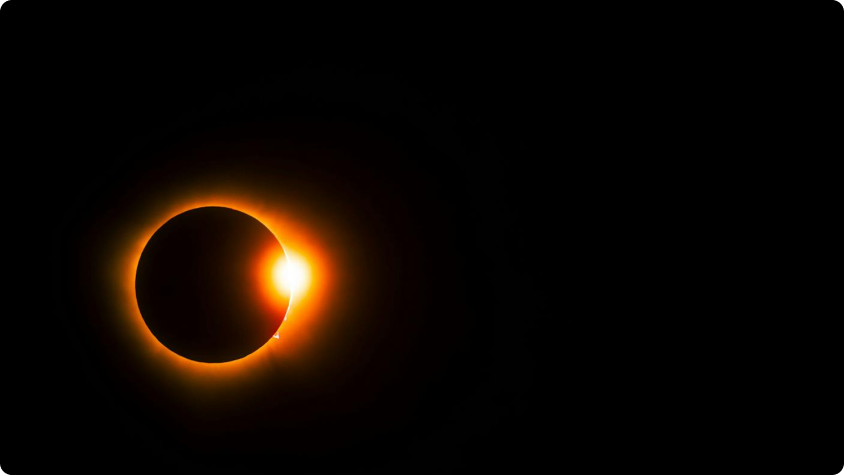October 2, 2024: Libra Solar Eclipse and the Bright Comet C/2023 A3
September 30, 2024

A solar eclipse occurs at the time of the New Moon when the Moon passes between the Earth and the Sun, partially or fully obscuring the Sun's disk as viewed from Earth. An annular solar eclipse happens when the Sun and Moon occupy the same declination within a one degree orb, both placed at a distance of 18 degrees 31 minutes zodiacal longitude of one of the Moon’s Nodes (North Lunar Node and South Lunar Node).
The bright Comet C/2023 A3 (Tsuchinshan–ATLAS) will be visible during this period, creating a truly memorable sky-watching opportunity.
The Eclipse Corridor: A Time of Intensity
The two weeks between the Lunar eclipse on September 17-18, 2024, and the Solar eclipse on October 2, 2024, are known as the eclipse corridor. During this period, energies are particularly strong and intense, making it a powerful time for transformation and new beginnings.
Solar Eclipse in Libra: Astrological Significance
This solar eclipse occurs at 10°02' in the sign of Libra, emphasizing themes associated with this air sign. Libra, ruled by Venus, governs relationships, harmony, balance, diplomacy, and justice. This eclipse may catalyze changes in these areas of life, with its effects varying based on its position in individual Natal Chart.
Venus, the ruling planet of the Libra eclipse, transits through Scorpio during this time. This placement is notable for its high emotional tension, potentially creating challenges in relationships and intensifying emotional expression. However, Venus forms favorable trines with both Saturn and Mars, offering opportunities for peaceful problem-solving through diplomacy, self-control, and restraint.
Planetary Conjunctions Amplifying the Eclipse Energy
Mercury Conjunction
The eclipse forms a close conjunction with Mercury, the planet of communication and intellect. This alignment intensifies the focus on communication within relationships. It deepens the mind and opens perceptions, confirming the need for cooperation and interaction with others for the next few months.
Lilith (Black Moon) Conjunction
From a mythological perspective, Black Moon Lilith embodies the mysterious goddess of sex and the terrifying queen of demons. She is often portrayed as an evil yet beautiful seductress, reflecting our hidden inner desires.
Astrologically, Lilith represents the dark side of the Moon, associated with our psychic experiences and showing our karma, temptation, independence, breaking taboos and areas where others may find us dangerous or destructive.
The Lilith conjunction with eclipse may bring hidden or repressed issues in relationships to the surface.
Comet C/2023 A3 Near EARTH
The comet is exceptionally bright and may be visible to the naked eye, reaching its peak brightness on October 12 when it makes its closest approach to Earth.
Discovery and Naming of Comet C/2023 A3 (Tsuchinshan-ATLAS)
Comet C/2023 A3 (Tsuchinshan–ATLAS) was discovered in 2023. The comet's name includes information about where and when it was first observed:
* The letter 'C' indicates that the comet is non-periodic
* '2023 A3' means the comet was discovered in 2023, during the first half of January
* 'Tsuchinshan–ATLAS' signifies that the discovery was made using telescopes at the Tsuchinshan (Purple Mountain) Observatory and the ATLAS system
Comets like C/2023 A3 originate from the Oort Cloud and pass through the Solar System only once.
Trajectory and Visibility
The comet is currently positioned in the constellation Leo, with its trajectory passing close to the planets Mercury and Venus. It's moving from the constellation Hydra towards Virgo, and will notably pass north of the bright star Spica in Virgo.
Comet C/2023 A3 is exceptionally bright and may be visible to the naked eye. It will reach its peak brightness on October 12 when it makes its closest approach to Earth.
Currently, the comet is visible in the Southern Hemisphere, appearing low in the eastern sky just before sunrise. For the best view, observers are recommended to use binoculars or a small telescope. Viewers in the Northern Hemisphere may find it challenging to spot the comet due to its proximity to the horizon and the Sun's brightness.
Astrology perspective on Comets
Some astrologers view comets as harbingers of global changes and potential dangers. As it approaches Earth around October 12, the comet is expected to have a surge of energy.
The comet's passage near Earth coincides with a powerful New Moon and Solar Eclipse period. Given this celestial alignment, astrologers recommend:
* Clearly defining your goals
* Directing your thoughts positively
* Being cautious in communication
These practices may help navigate the intense energies of this period and harness them for personal growth and transformation.
When is the next solar eclipse?
The next solar eclipse occurs on March 29, 2025 at 8°53' in the sign of Aries. The maximum eclipse will happen at 10:48 AM UTC.
Solar and lunar eclipse calendar